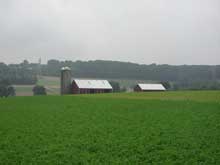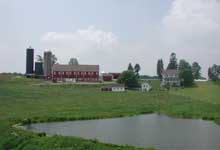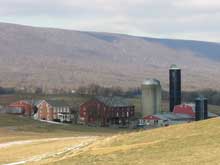Agricultural Historic Landscapes
Evaluating a farmstead for agricultual significance requires examination of the inter-relationship of the buildings to one another and the surrounding open space. The farm fields, hedgerows, natural land features and the placement of buildings are all important elements to consider. A farm complex may contain numerous primary buildings and outbuildings of varying eras. Common agricultural buildings in Pennsylvania include farm houses, barns, tenent houses, milk houses, silos, smokehouses, springhouses, root cellers, wash houses, summer kitchens, outhouses, stables, carriage houses, mushroom houses and chicken coops.
It is necessary to evaluate each farmstead in context to the surrounding agricultural area. Toward that effort the PHMC and PADOT have undertaken an extensive study of historic agricultual patterns in the various regions of the state to better understand differences and commonalities. Common patterns may be noted such as the location of the house and barn accross the road from one another, type of farm house or barn erected, typical acreage of each farm, number or assortment of outbuildings and crops produced. Looking at farmsteads within a larger context allows us to better evaluate individual resources and to look for broader historic resouces as well.
Rural historic districts are comprised of a number of farmsteads which viewed as a single landscape, reflect the historic agricultural patterns of the area. While in Pennsylvania's more rural, more agricultural past, broad areas of uninterrupted agricultural use would have been very common, today, with encroaching development, intact rural historic districts are more rare. One of the most distinctive rural historic districts indentified in Pennsylanial is the Brush Valley Rural Historic District in Centre County. This large district is defined by a bowl-shaped plateau of fertile agricultural land, resting on limestone bedrock. The land features clearly define this area and create common agricultural practices within that make it a discernable and distinctive district. It can be more difficult to establish clear boundaries for other rural historic districts without such pronounced geographic features. Sometimes those previously much larger agricultural areas have been pared down by modern development, or altered by highway and road construction. Evaluation requires not just research into the historic agricutural practices of the area, photographs of all contributing structures and aerial views of the landscape, but site visits to fully experience the setting or feeling of the district.
Another issue to consider in the assessment of rural agricultural landscapes is evidence of ethnographic cultural significance, such as the Amish presence throughout central and southeast Pennsylvania. This concept of traditional cultural properties has most often been applied to Native American settlements, but may also apply to other cultures whose folkways and land use patterns are distinctive. National Register Bulletin #30 "Guidelines for Evaluating and Documenting Rural Historic Landscapes" and National Register Bulletin "Guidelines for Evaluating and Documenting Traditional Cultural Properties" are good resources to better understand these issues.
Photos

Agricultural Landscape, Chester Co.

Farm Complex, Lancaster Co.

Farm Complex, Mifflin Co.